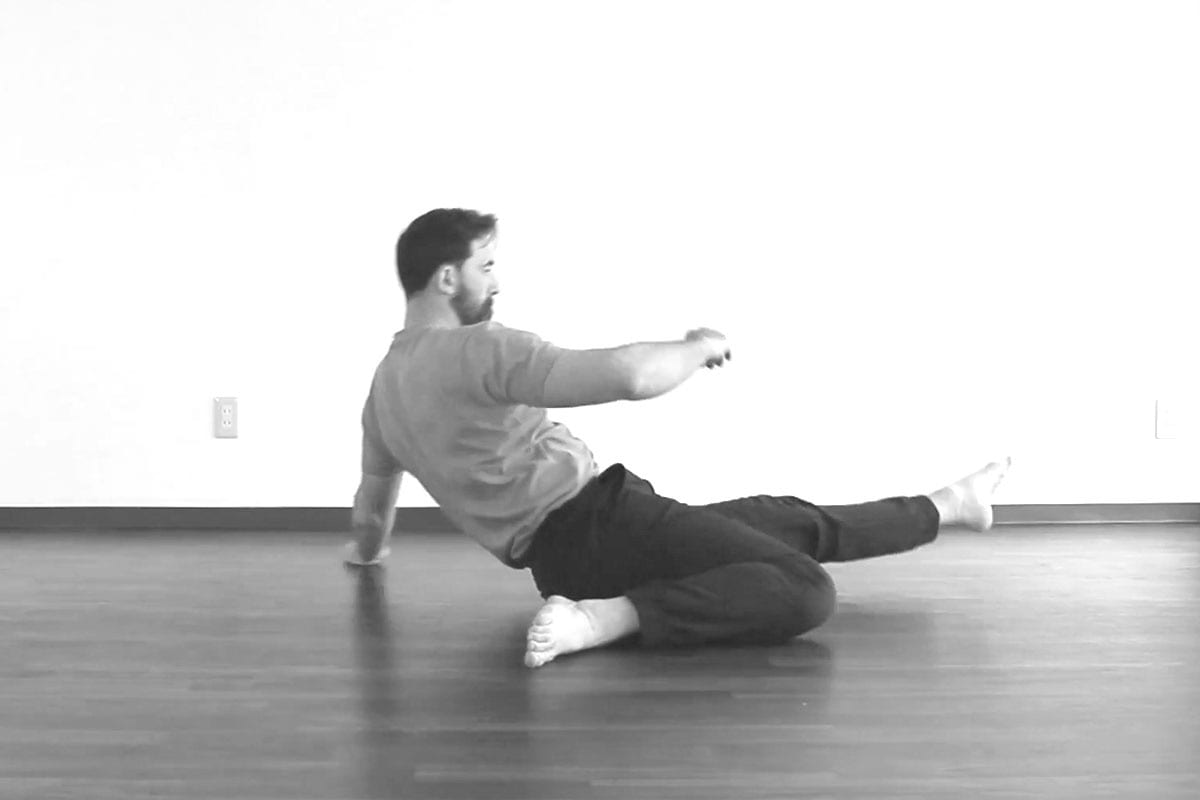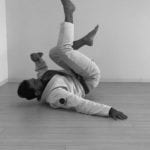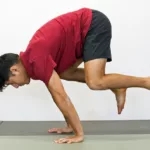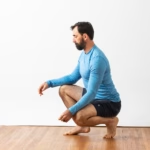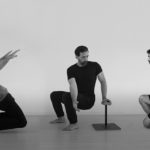Contents: What are Transitional Movements? (Video) / Benefits of Training Transitions / How to Work on Transitional Movements
You can build a strong back and beefy legs by doing one movement over and over again. People have done that for thousands of years. But isolated reps won’t get you anywhere if you can’t connect them in real time. In real life, we move to actually make things happen. This means doing linking movements together in a variety of ways.
It’s not: squat ten times, rest. Bend forward five times, rest. Twist, rest.
It’s: bend, turn, reach, and adjust on the fly.
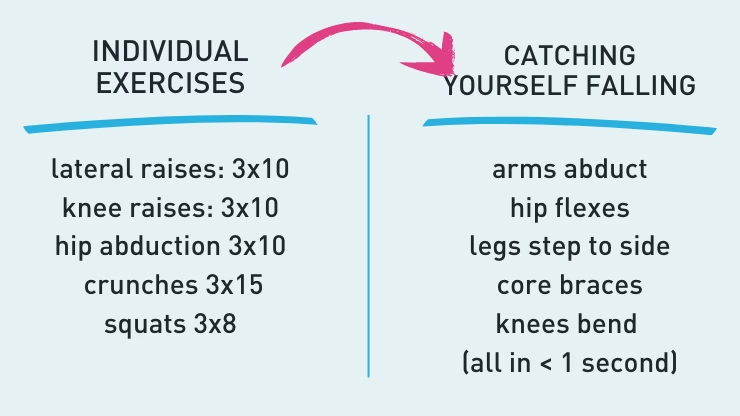 Our tasks shift and change with nearly each move we make, so we do too. Because movement isn’t for movement’s sake. We move around to get things done!
Our tasks shift and change with nearly each move we make, so we do too. Because movement isn’t for movement’s sake. We move around to get things done!
You can have strength and mobility separately in your hips and knees, and still struggle to crawl through the attic or wedge under your sink to mess with the pipes. Life is continuous movement, not one thing at a time. To get better at it, you need to train the transitions in between the big moves.
Most people never train that. And that’s exactly why they’re not actually getting better at the stuff they think they’ve prepared for. If things still feel awkward or out of sync when it gets dynamic and unpredictable, you’re not alone.
What Exactly Are Transitional Movements?
When we say “transitional movements,” we’re talking about the in-between parts, how you shift from one position or motion to another. It can be a simple as changing direction when you’re walking and keeping your balance. Seems easy enough but add on a few other things like faster speeds, carrying stuff in your hands, or looking around and that simple thing gets a lot tougher.
Sometimes it’s subtle. Sometimes fast or awkward. But it always tells you where your real control shows up. Transitions are everywhere. Training them makes you better at noticing, and owning, them.
In this video, Ryan demonstrates this….
Grab all the YouTube Cheatsheets here
And, despite what you might think, there are ways to work on these sometimes unexpected transitions.
4 Reasons You Should Be Spending More Time on the “In-Between”
We’ve already said that transitions are where the real progress lies and that without them, you’re only training pieces of what you need. Now let’s break down the specific benefits and how they translate into how you move and feel.
1. Agility: Fluid Control in Unpredictable Situations
“Movement combination is the progressive overload of agility training.”
The more you practice linking movements, the more agile and reactive you become. Athletes have known this for ages, that what separates somebody who’s just good from someone who’s great is how smoothly they can transition from one move to the next. In basketball, football, and soccer, you won’t get too far just charging forward. You need to stay on top of the ball but also react, cut angles, and make choices incredibly quickly without hesitation. One stutter can cost you the point, and the game.
A great example is changing levels and directions at the same time; such as rotating on the balls of your feet from stooping low to rise up and throw a ball. Something baseball players have to do without thinking and makes for great highlight reels!
And you can’t do that without mastering putting movements together.
2. CNS Coordination: Better Input = Smarter Output
“You get more from your existing strength when your nervous system is in the driver’s seat.”
I’m sure you’ve found out by now; gaining strength by itself doesn’t guarantee feeling better when you move. For that to happen, you need to get better at coordinating your strength, pulling together that force and aligning it in all your body parts. That’s when you’ll find yourself getting smoother and more efficient in every action.
This effect occurs when your nervous system learns how to coordinate your attributes (strength, flexibility, speed) towards your intentions. Training transitions builds those neural connections across your joints, force vectors, and timing. You’re programming your body to respond quickly and appropriately.
Brute force can only take you a few steps, but it’s smart coordinated outputs gets things done.
Over time, this turns into true ease in your movements, and you feel sharp and connected. Noticing things like catching your balance quicker, reacting and moving faster without feeling rushed. You get more done with less tension, less wasted motion, and far less strain. That’s the true meaning of efficiency in action.
3. Injury Resilience: Moving Well Means More Durability
“Typically, the transition is where people get injured. By performing that transition as smoothly as possible with confidence, you avoid that fear of injury.”
Most injuries don’t happen during that nice clean and direct squat repetition. They happen when you need to quickly do two or three things at once; a lunge with reach and twist or jumping from side to side and then back again,
They happen between positions and during the changes. On the landing, the redirections and the shifts. That moment when you’re not in complete control and caught by surprise.
Transitions condition the tendons, joints, and tissues to handle these awkward angles and stresses. A lot of injury resilience is the ability manage force and quickly adapt when the situation isn’t perfect.
Elasticity, responsiveness, and structural awareness are the keys to success here.
And maybe most importantly, you build the habit of reacting calmly instead of panicking. It’s that split-second of control that keeps you from crashing down hard. Poor mechanics and poor attention are not a great couple.
Transitional training gives you this crucial buffer of time to mitigate injury before it happens and is well worth the time spent.
4. Lifelong Capability: Movement Confidence That Grows Along With You
“You should feel like your body can handle whatever life throws at it.”
You should be strong, we can never argue against that, but if that strength falls apart the moment you’re just a little off balance or off pace, it’s not helping you much outside the gym.
A big part of feeling and being physically capable is having confidence in yourself. Knowing that you can automatically pivot, twist, or recover without needing to brace or overthink. That you’re not going to freeze or stumble when things don’t go exactly to plan.
This “movement confidence” gets trained and ingrained when you’ve worked to clean up those messy, in-between moments. Transitional work teaches your body to trust itself in imperfect conditions when angles get weird and you need to be quick and agile.
Lifelong capability does mean retaining strength and mobility, but not because you’ve developed them to their maximum. It’s when you’ve given yourself more movement options. Adaptability is a massive part to resilience that most people can miss.
That’s what healthy longevity really looks like. It’s durability and adaptability; you know that you’ll still be moving well years from now because you’ve trained to handle what’s coming, even when you didn’t expect it.
Train The Parts Most Workouts Miss
How do you put this into practice?
Well, the first step is a shift in how you think about your training, and what exercises “should” look like.
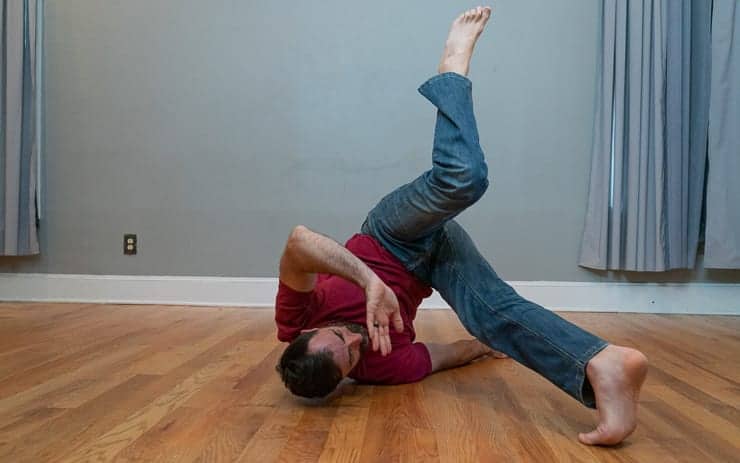
When you go into a gym, or even if you’re watching people do calisthenics in the park, 99% of what you’re going to see is linear movement, exercises that either move in an up/down pattern or a side/side pattern.
Most training only covers the individual parts of movement. But to truly move well you have to train how those parts fit together. Start with shifting your mindset about what effective training looks like. You’ve probably been told that exercises should be clean, linear, and repeatable. And that’s a good start, but you have to move on from that and train for messy, curvy, and unpredictable.
Try This: 3 Ways to Get Better at the Movements In-Between
The concept of training the “in-between” is pretty novel for most people, and can seem a bit vague at first. How can you actually go about doing this? Here are 3 suggested things you can try:
1. Hang Out in Your Weak Spots
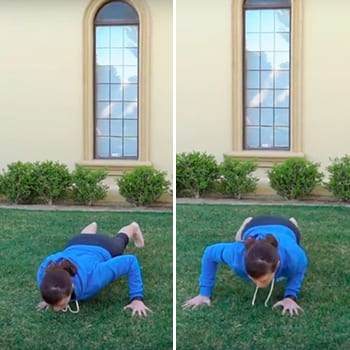 This can be an uncomfortable and rude awakening for a lot of people. Rather than rushing through the weakest part of an exercise, take some time to hang out there, move around, and explore.
This can be an uncomfortable and rude awakening for a lot of people. Rather than rushing through the weakest part of an exercise, take some time to hang out there, move around, and explore.
If you’re working on push-ups, for instance, you might find that the bottom 6 inches are the weakest for you—you have to use a lot of momentum to push yourself up from the bottom each time, but once you get past those 6 inches, you’re good to go.
So, instead of quickly pushing through that part of the exercise, spend some time in that weak spot.
Maybe push yourself up just 3 inches and hold, then shift your body forward and backward, side to side, in circles, diagonally—play around in all directions, then lower yourself back down to the ground. Work on this for a while and you’ll find find your strength and control will improve drastically in the push-up (and that’ll carry over into lots of other areas).
2. Move Around in the Squat
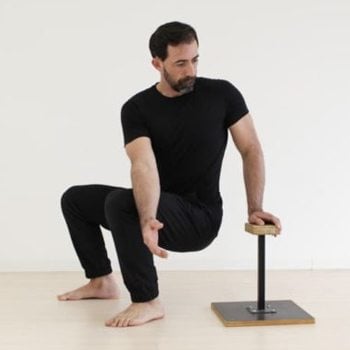 The squat is one of our favorite exercises to play around with these kinds of “in-between” movements or positions. That’s because, for one thing, getting strong and controlled in your squat means you’ll be stronger and more controlled in whatever you need to do. For another thing, it’s such a versatile exercise that can be practiced in so many different ways.
The squat is one of our favorite exercises to play around with these kinds of “in-between” movements or positions. That’s because, for one thing, getting strong and controlled in your squat means you’ll be stronger and more controlled in whatever you need to do. For another thing, it’s such a versatile exercise that can be practiced in so many different ways.
✅ Related all about the squat.
Even if you’re not able to do a deep squat right now, there’s still a lot you can work with. You can hold on to something to keep yourself from falling over, or you can even squat down onto a low stool.
Play around with squatting down then twisting your body one way and then the other. Move your knees in and out, one at a time, and then both together. Shift your weight forward and backward, then try to shift your weight all the way onto one foot, then the other.
When you’re comfortable with that, play with placing your hands on the ground in front of you, jumping your feet forward to meet your hands. Then do the same to one side and the other.
Now, try rotating as you squat down, or squatting with one foot snaked behind the other.
The possibilities are endless! (See what I mean about versatility?). No matter how you slice it, playing around with awkward positions within the squat will make you stronger and more controlled in those “in-between” positions. Which brings me to the next tip…
3. Practice Movements That Feel Awkward
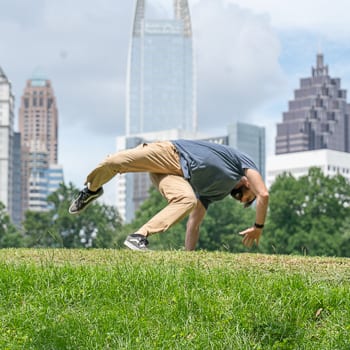 Getting into awkward or uncomfortable positions may not sound like a lot of fun, but actually, it can be just the opposite!
Getting into awkward or uncomfortable positions may not sound like a lot of fun, but actually, it can be just the opposite!
It’s of course much easier to simply repeat the things we’re good at. After all, we’ve all spent time learning and improving them. There’s a lot of mental effort and frustration when we first pick up something new, yet as we all know, that’s how we grow, both mentally and physically.
But here’s the trick: You don’t have to do something fully new every time to benefit. In fact, as we explain in our definition of Play, it’s better to take movements and abilities that you do well and explore how you can mix them up a bit.
Changing things up and doing things that you’re not used to doing is a great way to challenge your brain and body while having a lot of fun.
✅ Related 57 ways to get more movement.
Making Transitional Movements Your Secret Weapon for Successful Practice
Every day throws unexpected movement at you. Twists, pivots, recoveries, off-angle maneuvers. The smoother you can connect your movements, the better you handle it all. You don’t need another program promising to make you more explosive. You need one that helps you move smarter, more confidently, and without hesitation.
Sequences: Movement Flow Program
If you’ve got some experience with in movement training, Sequences is our new program to help you develop more complex skills and combine them into smooth, continuous flows routines.
